US to Ethiopia power adapters - do you need to bring an adapter to Ethiopia?
What adapter do I need for Ethiopia?
You need to pack a Type E plug adapter for Ethiopia if your plug won't fit into an Ethiopian power outlet.
The type of power adapter, power converter or charger that's needed when visiting Ethiopia all depends on the voltage and type of device that you're trying to charge in an Ethiopian power outlet. If you're unsure of which voltage your device uses then read the section on how can you tell if you have a single voltage or dual voltage device first.
- Be prepared for regular blackouts and limited access to electricity in some areas of Ethiopia, we suggest bringing a portable charger if you wish to recharge your cellphone battery whilst staying in a region without access to electricity or during a power outage.
- If you're from America visiting Ethiopia you will need to bring a power adapter to fit a US plug into an Ethiopian power outlet. Because the voltage is different in Ethiopia you will also need to use a power converter for Ethiopia if your device isn't dual voltage and ensure that it will work with a 50hz power outlet.
- If your device is 220 volts or is dual voltage and the plug will fit in an Ethiopian power outlet then it should work in Ethiopia.
- If your device can run on 220 volts or is dual voltage but your plug doesn't fit in an Ethiopian power outlet you'll need a suitable plug adapter for Ethiopia such a Type E plug adapter. A plug adapter for Ethiopia (or power adapter) will only change the actual shape of the plug on your device to fit into a plug outlet found in Ethiopia, but doesn't convert the voltage from 220 volts to a different voltage.
- If your device doesn't run on 220 volts and isn't dual voltage you will also need a power converter for Ethiopia to convert the voltage from 220 volts to the correct voltage for your device. You'll still need to use a suitable plug adapter for Ethiopia if the power converter doesn't include the correct Type E plug adapter.
- If you simply want to power USB devices such as a tablet or mobile phone then a USB travel power adapter is suitable and it will work with any voltage, however ensure that you choose to bring one which includes a Type E plug adapter otherwise you will also need to pack a suitable plug adapter for Ethiopia. [3] [AD]
Ethiopia power adapters
Power adapters for Ethiopia
Varying different combinations of voltages and standards can often be confusing when planning to travel to a different country to the first time traveller. However this isn't as complicated as it first appears, with only a handful of different types of plug sockets being used throughout the world this article shows exactly what you'll need in advance to power your electronics in Ethiopia. This page has links to instructions showing which power adapters you'll need to charge your devices in Ethiopia by using the standard types E, C, F or L Ethiopian 220 volt 50Hz wall outlets. Most power sockets will vary regionally so please read the power adapters page for a full list of regions and countries.
What is the best power adapter for Ethiopia?
The best power adapter for Ethiopia is a Type E power adapter which is suitable for powering any 220 volt appliance or device. [3] [AD]
What is a power adapter for an Ethiopian power outlet?
A power adapter is a compact, cheap and lightweight plastic adapter which permits an Ethiopian power outlet to accept a different shaped power plug from an appliance from another region.
Also known as: an electrical adapter, plug adapter, travel adapter, electrical adaptor, mains travel adapter or power adaptor. [5]
Do I need a plug adapter for Ethiopia?
If the type of Ethiopian power outlet isn't the same as the type of Ethiopian power outlet then you will need a power adapter.
Do I need a power adapter if I'm visiting Ethiopia from America?
A US plug won't physically fit in an Ethiopian power outlet so you will need to use a power adapter for Ethiopia, and because the voltage is much higher you will also need to bring a power converter for Ethiopia to prevent damage or overheating to your device or appliance if it isn't dual voltage.
Will a power adapter convert the voltage in Ethiopia?
A power adapter only adapts the shape of a plug to fit into a 220 volt Ethiopian power outlet and can't convert the power to a higher voltage. Should you need to safely use any 100-120 volt device you also need to bring a step down power converter along with the right type of power adapter.
What does a power adapter for Ethiopia do?
A power adapter allows visitors from a different country to use electrical appliances in Ethiopia simply by adapting the shape of the power plug from one shape to another.
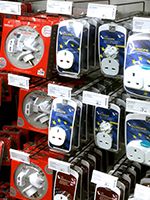
Power adapters for sale in an airport
Where to buy a power adapter for Ethiopia in the US
Ethiopia to US power adapters will most likely be available in most major US International airports prior to departure, however the range of adapters might be limited to popular destinations. It is recommended to research the exact type of adapter required prior to shopping at the airport. Look in the travel accessories section of airport newsagents, electronic stores and pharmacists such as Hudson News or Brookstone, but expect to pay more than regular prices. Airports will be your last chance to buy a power adapter before departure, always check the returns policy to ensure you can easily exchange or refund a faulty or unsuitable product in an airside shop.
It will be more convenient and cheaper to buy the correct power adapter in advance of your trip. High street electrical stores such as Best Buy, Walmart, Target, Home Depot or Fry's normally sell a limited range of travel adapters to popular locations but for widest choice it is recommended to buy a power adapter online.
Electrical adapters for Ethiopia
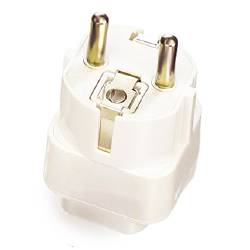
An easy to use Type E plug adapter
Power Plug Adapters
Benefits of a power plug adapter
- Simple to use.
- Cheap.
- Light and compact.
- Bringing a Type E plug adapter will work in Ethiopia.
Disadvantages of a power plug adapter
- Accomodation might only have one wall outlet, so you will only be capable of charging a single appliance at once.
- Should you intend to travel to more than just Ethiopia you may need to bring multiple plug adapter types.
- A single power adapter for each device - for every separate device or appliance you want to bring you will also need to use a separate adapter.
- Only modifies the shape of the plug to fit in a Type E Ethiopian power outlet and not the actual voltage used in Ethiopia, so if your appliance doesn't work with 220 volts and isn't dual voltage then you will still need to bring a voltage converter.
- You'll also still need to pack a separate domestic USB charger as well if you wish to power any USB device. [3] [AD]
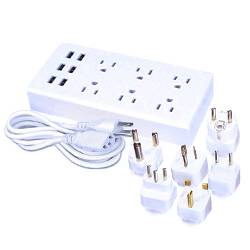
Travel power strips including adapters
Travel Power Strips
Benefits of a travel power strip
- Capable of charging more than one electronic appliance simultaneously via a single Ethiopian power outlet.
- Some models offer voltage conversation for low wattage electronics such as laptops or cameras. Therefore if your appliance isn't dual voltage it can still be used in Ethiopia by using a travel power strip, making them a cheap and lightweight alternative option to a voltage converter.
- Some models include multiple USB charge ports.
- Offers surge protection. Voltage from power outlets in certain areas might be unstable, a sudden power surge will damage devices. Some models have a built in surge protector to protect your electronics from being overloaded.
- It will be functional when you return to America as a power strip.
- US and Canadian power strips include Type A, B, D, E/F, G, H, I, L and N plug adapters so should work in Ethiopia.
Disadvantages of a travel power strip
- The converter on a travel power strip won't support higher wattage appliances such as hair straighteners or curling irons.
- Due to the size of a power strip it might be too bulky for hand luggage.
- Travel power strips might be excessive for travellers with only a small number of appliances and devices to charge. [6] [AD]
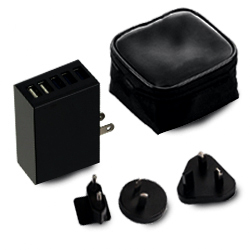
A USB travel charger with changable heads
Travel USB Wall Chargers
Benefits of a travel USB wall charger
- Ideal if you only have to power USB devices.
- Rather than bring lots of domestic USB power chargers travellers only have to bring a single unit.
- Supplied with interchangeable adapter heads which make them useful in a large number of different countries. The interchangeable adapter heads are typically small and lightweight making them easy to pack in hand luggage.
- Offers surge protector built in.
- The charger could still be of use back home.
- Swappable plugs fit in Types A/B, E/F, G and I outlets so will work in Ethiopia.
Disadvantages of a travel USB wall charger
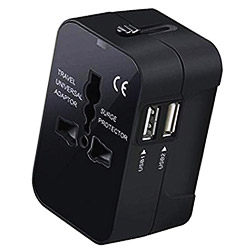
A universal travel adapter
Universal Travel Power Adapters
Benefits of a universal travel power adapter
- Typical models work in over 150 different countries.
- An all in one compact design. Both small and lightweight.
- There are some models which include charging ports for USB devices.
- Relatively straightforward operation.
- There are some universal travel power adapters that include a surge protector built in, this will prevent any device from being overpowered by an unstable power grid in some countries.
- The pins retract so won't catch against other items when packed in your baggage.
- It will be functional domestically as a USB charger.
- Changes shape to Types A/B, E/F, G and I plugs so should fit into an Ethiopian power outlet.
Disadvantages of a universal travel power adapter
- Must not be used with high power appliances such as hair straighteners, kettles or hair dryers.
- Shutters and moving parts could be fragile on some universal travel power adapters which might make them prone to breaking when travelling.
- Only charges a single plug.
- Might not work in some countries; some adapters might not work in certain countries with less popular outlet types.
- Lacking a power converter means it won't be suitable for non-220 volt electrical appliances. [8] [AD]
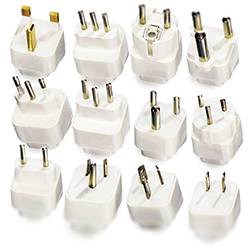
Cost effective plug adapter set
Plug Adapter Sets
Benefits of a plug adapter set
- A set works out more cost-effective than purchasing individual plug adapter types.
- Covers all eventualities.
- If you are visiting multiple locations this is the most flexible option.
- Each power adapter set includes Type A, B, C, D, E/F, G, H, I, J, L, M and N plugs so should operate in Ethiopia.
Disadvantages of a plug adapter set
- Will involve some planning; you will need to decide which adapters to pack, if you don't know every country you'll be visiting you'll need to pack each power adapter in the set along.
- Lots individual plug adapters to bring with you.
- The remaining plug adapters will be useless and using up packing space.
- Not every power adapter types are typically included with each set (and especially less common adapters), so ensure that your set includes one that is compatible with an Ethiopian power outlet.
- A plug adapter only changes the shape of the plug to allow it to fit into an Ethiopian power outlet but not the voltage. [9] [AD]
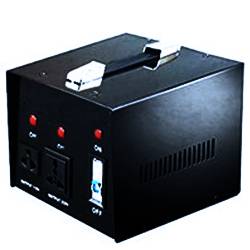
Voltage converters have surge protection
Voltage Converters
Benefits of a voltage converter
- Step down voltage converters will let you to use any non-220 volt appliance with a 220 volt Ethiopian power outlet.
- A voltage converter has a built in surge protector to protect any device from being overpowered by an incorrect voltage.
Disadvantages of a voltage converter
- It will only change the 220 volts in Ethiopia and won't change the actual shape of the plug to slot into a Ethiopian power outlet, therefore you will still be required to use the correct type of power adapter.
- The weight of voltage converters makes them too heavy and bulky for packing in hand baggage.
- A voltage converter won't be useful when get back home.
- Usually less expensive to purchase a dual voltage travel appliance than to buy an expensive power converter simply in order to power your existing single voltage appliance in an incompatible location.
- When you travel from America go to Ethiopia then you will require a voltage converter as the voltage in Ethiopia is 220 volts.
Comparison of electrical adapters for Ethiopia
| Type E Power Plug Adapter |
Universal Travel Power Adapter |
Travel USB Wall Charger |
Travel Power Strip |
Plug Adapter Set |
Voltage Converter |
|
|---|---|---|---|---|---|---|
| Can be used in Ethiopia | Yes | Yes | Yes | Yes | Yes | Yes |
| Types of plug included | E | A/B, E/F, G and I | A/B, E/F, G and I | A, B, D, E/F, G, H, I, L and N | A, B, C, D, E/F, G, H, I, J, L, M and N | B |
| Compatible number of countries (A) | 35+ | 150+ | 150+ | 200+ | 230+ | 230+ |
| Fits in a Type E Ethiopian power outlet | Yes | Yes | Yes | Yes | Yes | • |
| Additional Type E plug adapter required to fit in an Ethiopian power outlet | • | • | • | • | • | Yes |
| Useful when you return to America | • | Yes | Yes | Yes | • | • |
| Typical combined number of USB ports and AC outlets | 1 | 3 | 4 | 7 | 1 | 2 |
| Powers USB devices | • | Yes | Yes | Yes | • | • |
| Typical number of USB ports | 0 | 2 | 4 | 4 | 0 | 0 |
| Powers a 220 volt AC appliance in Ethiopia | Yes | Yes | • | Yes | Yes | Yes |
| Typical number of AC outlets | 1 | 1 | 0 | 3 | 1 (B) | 2 |
| Converts voltage (?) | • | • | • | Yes (C) | • | Yes |
| Surge protection | • | Yes | Yes | Yes | • | Yes |
| Typical dimensions | 2.6 x 1.9 x 1.4 inches | 3 x 2.1 x 2.1 inches | 4.3 x 3.4 x 1.3 inches | 6.6 x 3.6 x 1.5 inches | 7.1 x 3.9 x 2.8 inches | 11.7 x 8.1 x 6.7 inches |
| Typical weight | 4.5 ounces | 4 ounces | 4.5 ounces | 1.6 pounds | 13 ounces | 20 pounds |
| Typical number of items to carry (D) | 1 | 1 | 5 | 8 | 12 | 2 |
| Suitable for hand luggage | Yes | Yes | Yes | • (E) | • (F) | • |
| Buy | Buy | Buy | Buy | Buy | Buy |
Ethiopia power outlets and plug sockets
What plug sockets are used in Ethiopia?
There are four different types of power outlets used in Ethiopia, types E, C, F and L with the primary power outlets being type E:
- Plug Type C - You can recognise this wall outlet by 2 adjacent holes next to each other where the live and neutral plug socket pins go.
- Plug Type E - You can identify this wall outlet by two 4.8mm round adjacent holes next to each other and one metal earth pin protruding from the top to form a triangular pattern.
- Plug Type F - You can recognise this power outlet by two holes 19 mm apart from each other for live and neutral along with grounding clips on the top and bottom.
- Plug Type L - You can identify this hexagon shaped wall outlet by 3 circular adjecent holes forming a line for live, neutral and earth pins. Note that there are two different types of Type L power outlet rated for 10 amps and 16 amps. A 10 amp version has 4mm thick round pins that are spaced 5.5mm apart, whilst the 16 amp version has slightly larger 5mm pins spaced 8mm apart. [3] [AD]
Do US plugs work in Ethiopia?
No - an American plug won't work in Ethiopia because it won't fit into an Ethiopian power outlet without using a power adapter. The voltage is 220 volts so you will need to use a power converter for Ethiopia if your device isn't dual voltage and check that your device will work with a 50hz power outlet.
Are outlets in Ethiopia the same as in the US?
An American plug won't fit in an Ethiopian power outlet so use a power adapter for Ethiopia. Both the voltage and frequency are different so if your charger or appliance isn't dual voltage use a power converter for Ethiopia and ensure that it works with 50hz.
Is the voltage in Ethiopia the same as the US?
The voltage in Ethiopia is 220 volts, but 120 volts is used in America. If your American appliance or power charger won't handle dual voltage then you should use a power converter for an Ethiopian power outlet which can change the voltage from 220 volts to 120 volts.
What electrical frequency is used with an Ethiopian power outlet?
The frequency from an Ethiopian power outlet is 50 Hz. [11]
How do I use a 110 volt appliance in Ethiopia?
A step down power converter will allow you to use a 110 volt or 120 volt appliance in Ethiopia.
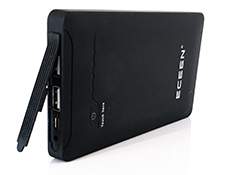
Power bank for charging phones
Should I pack a power bank for Ethiopia?
As power isn't available in all areas of Ethiopia together with potential power outages, travellers are advised to pack alternative charging solutions if they wish to continue charging devices such as phones or eReaders.
- Whilst travelling increased use of smart phones for taking photos, storing calendars, GPS, social networks and playing games will syphon off power towards the end of the day. Beyond just missing photo opportunities this can possibly leave you stranded without adequate power to make an emergency call or being able to use a sat nav app to return back to your accommodation. Bringing a 10,000mAh power bank eases those concerns as it means you can keep your smart phone powered without needing an Ethiopian power outlet, especially when visiting a country with a lack of access to power and power outages in some areas.
- We recommend bringing at least a 10,000mAh portable charger which will store enough electricity to cover around 3 full cycles and a 20,000mAh power bank should keep a typical smart phone charged for roughly seven days depending on the model of phone and usage. The mAh value (milli ampere-hours) shows the capacity of the battery giving an indication of how many charges the power bank can do, and a higher number will be better for travellers.
- Should you need to charge your laptop with a power bank in Ethiopia and it uses a USB-C charging port then pack a portable charger for a laptop marked with PD (power delivery) which supplies 20 Wh or more.
- Please note that some airlines prohibit portable chargers on an aircraft with more than 100 Wh of power and must not be kept in the hold so always ahead with the airline first.
- Small consumer power banks won't work with high wattage items, although a rechargeable hair dryer or rechargeable cordless flat iron are designed for travelling to areas with power cuts and limited access to electricity such as Ethiopia. [4] [4] [12] [13] [14] [15] [AD]
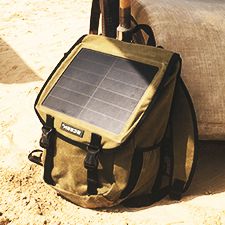
Solar backpacks are ideal in hot weather
Will a solar charger work in Ethiopia?
The climate in Ethiopia should be adequate enough to recharge solar power bank dependably, however it will need to be exposed to strong sunlight in order to provide adequate energy for a single charge. This might prove inconvenient to continually unpack a solar power bank and wait for it to recharge in sunny spells.
- The larger solar cells used on a solar backpack will give the backpack the ability to create more electricity within a shorter period of time and should also generate a smaller charge when cloudy, making them ideal for the climate in Ethiopia.
- A device that has been directly plugged into the USB charging port of a solar backpack can gradually recharge the power during sunny spells in Ethiopia, but might be inconvenient to have it continuously connected in the bag during the day should it be needed constantly. A normal power bank plugged in a solar backpack can be continuously recharged during the day, afterwards the phone can be powered up using the power bank without being attached to the bag.
- Although the sunlight in Ethiopia is strong, a bag should ideally have a solar cell efficiency of 22% or more, can generate a minimum of 6 watts of power and includes a power bank of 10,000mAH or stronger.
- Unlike normal solid solar panels, the flexible and durable solar cells used in solar powered bags have been built to endure bending and scratches. Solar bags are available in backpack, messenger and rucksack styles making them ideal for domestic, travel and work use. [4] [16] [17] [AD]
Sources
- International Electrotechnical Commission - World plugs by location (cited August 2014)
- Wikipedia - Mains electricity by country (cited July 2014)
- Index Mundi - Power outages in a typical month (cited May 2018, data collected between 2006 to 2017)
- Index Mundi - Access to electricity (cited May 2018, latest data collected 2010)
- WikiPedia - List of countries by average yearly temperature (cited May 2018, data averaged between 1961 to 1990)
Ethiopia chargers
What is a USB travel power charger?
A USB travel charger is a dual voltage charger with interchangeable plugs and multiple USB ports, suitable for charging multiple USB powered devices when travelling abroad.
What USB charger do I need for Ethiopia?
When travelling with more than one device then the best international travel power adapter for Ethiopia to buy is a multiple USB port adapter which includes compatible plugs such as a 4 port USB travel charger. Ethiopians use four different types of plug sockets (E, C, F and L) and bringing this will ensure that you are covered for type C.
As these types of chargers come with interchangeable plugs and can handle from 100 - 240 volts it makes them ideal for multiple countries around the world simply by switching the included heads over. If your model of device can support Fast Charge (please note that not all USB devices do) then you will benefit from quicker charging times with one of these power chargers and additional compatibility with more power hungry devices like tablets.
Having a four port charger means you can power multiple devices simultaneously without needing to buy multiple travel adapters on your trip to Ethiopia. Because you are only bringing a single travel charger will keep the overall weight and size down, making it ideal to fold up in hand luggage whilst travelling. Due to their flexibility these types of travel chargers can be used back at home as well as abroad so when you’re not travelling they can sit under your bedside table charging multiple tablets, phones and speakers with only a single wall outlet.
If you travel frequently we recommend searching for a multipurpose power charger similar to this at an electronics retailer. The travel adapter illustrated below is the 4 Port USB Wall Charger which has been tested successfully for recharging multiple USB devices in numerous foreign countries around the world with good reliably. [7] [AD]
Why use a travel USB charger for Ethiopia?
- Typically travel USB chargers include multiple USB charger ports, this means that you now only need to bring a single charger to charge all your devices. Instead of bringing 4 separate power chargers it becomes only necessary to pack one 4 port USB wall charger and power up to 4 individual devices, thereby reducing the weight and size of your luggage.
- Travel USB chargers include interchangeable plug heads for different power outlet types making them perfect if travelling across multiple countries across Africa which are likely to use a different outlet to Ethiopia.
- Good chargers are compact, rugged and lightweight - ideal for rigors of travel instead of than risking packing a domestic charger which could be impossible to repair or replace in Ethiopia.
- USB travel chargers can accept both the 220 volts used in Ethiopia power outlets and different voltage standards across the world.
- There is a chance that accommodation or hotel rooms in Ethiopia might only have a single wall outlet, by using a travel charger with multiple USB ports means you can share out the single power supply with family or other traveler rather than waiting to charge one device at a time.
- Due to their versatile nature a travel USB charger takes the uncertainty out of visiting any unknown country as they are guaranteed to work almost anywhere in the world.
- Power outlets found in airports can be sparse and the demand for charging multiple cell phones and tablets before a flight can be high, so a USB charger with multiple ports and the ability to charge quickly is ideal.
- Some countries power grids are unstable, a travel USB charger allows for unexpected spikes and will help prevent damage to any devices attached to it. Attempting to repair an overloaded cell phone or tablet in Ethiopia could prove to be inconvenient and expensive.
- Higher priced USB chargers also feature power outlet strips to use low wattage domestic appliances such as laptops, however these will be unsuitable for high powered domestic such as hair dryers or clothes irons. Refer to our section on using travel appliances in Ethiopia for advice and guidelines on the best power adapter to use with an Ethiopian power outlet for high wattage devices.
- Some mobile phones could require more than the usual 500 milliamps produced from a standard 5 volt USB power adapter to charge or provide fast charge. Ensure that the USB power adapter can support fast charging should any of your devices draw additional power.
- Travel USB chargers can also be useful back at home by recharging multiple cell phones and tablets on a daily basis using only a single power outlet. [7] [AD]
What is the best USB charger for Ethiopia?
A 4 port USB travel charger is the most compact option for travellers from around the world wanting to charge devices via USB, but for visitors also wanting to use their domestic plugs these power converters provide larger but more versatile solutions. All three power converters offer surge protection which can be necessary when visiting counties with unreliable or unstable power supplies to prevent damage to any connected appliances from voltage spikes. These travel converters come with interchangeable type C, I and G plugs covering both Ethiopia and over 150 countries around the world:
- BESTEK Portable International Travel Voltage Converter - The BESTEK travel converter has 4 USB charging ports with 3 AC power outlets and is the most popular compact option for travellers originating from North America going to Ethiopia.
- ORICO Traveling Outlet Surge Protector Power Strip - Also having 4 USB ports but only 2 AC power outlets the travel adapter from Orico is also aimed at travellers from the US using type B plugs and gives practically the same set of features as the BESTEK with just 1 less AC outlet at almost half the price.
- BESTEK International USB Travel Power Strip - This power strip has 2 AC outlets but offers 5 USB charging ports. This versatile power strip is compatible with both American plugs and popular plug types A, D,E/F, G, H, I, L and N making it perfect for most travellers from around the world visiting Ethiopia. [7] [AD]
Power converters for Ethiopia
What does a power converter for an Ethiopian power outlet do?
A power converter for Ethiopia allows you to use a 100, 110 or 120 volt electric device with a 220 volt Ethiopian power outlet.
Also known as: electrical converter, electrical transformer, voltage converter, power transformer or voltage transformer.
What is the difference between a power adapter and a power converter for Ethiopia?
A small, cheap and lightweight power adapter (or plug adapter) will change the shape of the plug on your appliance to fit into a power outlet found in Ethiopia, but a heavier and more expensive power converter transforms a 220 volt Ethiopian power outlet to work with a non-220 volt device. [10] [AD]
Do I need a power converter for Ethiopia?
If visiting Ethiopia from another region double check your device will accept a 220 volt power supply.
- A step down power converter is needed if you are travelling to Ethiopia from a country that uses 100-120 volts and your appliance or device isn't compatible with 220 volts. Read our WikiConnections list of world power outlets page to see the voltage is used in your country.
- You don't need a power converter if you already use either a single voltage device that works with 220 volts or one that is dual voltage.
- Devices designed to use a lower voltage such as 110 volts and then used with 220 volts run the potential risk of a blown fuse, damage to your device or even an electrical fire hazard.
- You won't need a converter if you need to power a smaller electrical device such as a cell phone as these are typically support dual voltage and designed for international use, however always always check the device for dual voltage support first.
- For supplying power to appliances which draw more power or generate heat (for example hair straighteners or curling irons) then you will need to use a much larger higher wattage heavy duty power converter to allow the appliance to be used with a 220 volt Ethiopian power outlet.
- It could be more cost effective to purchase a smaller lightweight dual voltage travel appliance than carrying a much heavier power converter simply to use your existing domestic appliance.
- For more information read these comprehensive travel guides on how to use curling wands, clothes irons, hairdryers and flat irons in Ethiopia which includes recommendations for some affordable dual voltage alternatives. [10] [18] [AD]
Do I need a power converter for Ethiopia if I'm visiting from the US?
The 220 volts found in a wall outlet in Ethiopia is different to an American outlet, therefore you will need to bring a step down power converter if your appliance or charger doesn't support dual voltage. [10] [AD]
What kind of converter do I need for Ethiopia?
You need a step down power converter to use any 100, 110 or 120 volt appliance in Ethiopia. [10] [AD]
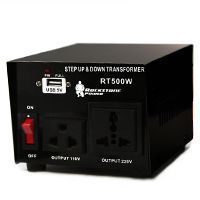
Voltage converter
What is the difference between a transformer and a power converter?
Converters and transformers are both used to change one voltage to another, but this ambiguity can cause confusion as their purposes are different:
- Power converters are designed for simple electrical appliances which typically generate heat or use motors such as clothes irons, shavers or hair dryers. Transformers are designed for more complex electronic items such as televisions or games consoles.
- Buying a power converter is cheaper than buying a power transformer.
- Power transformers are larger and heavier making them more suited for permanent residential use; for example an expat wishing to use an imported television would need to use a transformer for this purpose.
- Power converters are more suitable for travellers wishing to bring domestic appliances abroad such as hair dryers or flat irons. However, it is more practical and cost effective to purchase a dual voltage appliance designed for travel rather than a heavier power converter.
- Power converters are suitable for 2 pin ungrounded appliances, it could be harder to find a converter if you want to use a grounded 3 pin appliance.
- Transformers can be used constantly however it is recommended that converters are used for no longer than a couple of hours at a time.
- Shops may sell transformers under the name of converters, for the purposes this guide we will be referring to both converters and transformers as converters.
How to convert 220 volts to 110 volts
- Use a step down power converter to allow you to use a 110 or 120 volt appliance with an 220 volt Ethiopian power outlet.
- If the power converter doesn't include the correct shaped plug then it will also be necessary to plug in the power cord from the power converter into a power adapter for Ethiopia before plugging that into an Ethiopian power outlet.
- Some power converters include the ability to perform both step up and step down voltage conversions, therefore it may be necessary to manually switch the converter to output the voltage to the 110-120 volt range.
- Plug your appliance into the converter and turn the power on, your 110-120 volt appliance can now be used with an 220 volt Ethiopian power outlet. [10] [AD]
What voltage is used in Ethiopia?
Ethiopia uses 220 volts in their power outlets. [2]
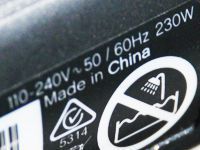
Dual voltage hair straighteners
How can you tell if you have a dual voltage appliance?
The easiest method to see if a appliance is dual or single voltage is to check for either a sticker or numbers printed on the supplied charger, or on the device itself, typically near to where the power cord plugs into. The location will vary depending on the make or model of your appliance and should also be written on the box or in the instruction manual.
- Single voltage devices might say a specific number - such as 120V.
- Single voltage devices might also have a small voltage range (20 volts difference) with a dash to accomodate small voltage fluctuations - such as 220-240V.
- Dual voltage devices will normally say a larger range separated with a slash - such as 100/240V.
Substantiations
See the power adapter substantions section for more information on how we compared travel adapters.
What type of adapter do you need for Ethiopia?
Which type of power adapter will I need to bring to Ethiopia?
The type of power converter or plug adapter that is best to bring to Ethiopia is dependant on various requirements. Prior to deciding which one to buy we suggest using this checklist:
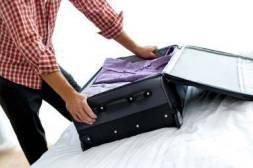
How many electrical devices are you bringing
How many electrical items will you be taking to Ethiopia?
- List all the electronic you intended on packing for Ethiopia (including cell phones, tablets, laptops, eReaders, curling irons and hair dryers).
- Allow for more devices in the future. Do you intend on buying a new tablet computer next year for example?
- There is a growing amount of smaller rechargeable electronics such as electric shavers which utilise USB charging as their power source. Therefore next time you buy a new device it could need a USB power adapter so please ensure your travel adapter has enough spare ports to power these additional devices too.
- Will you be travelling with a partner who might need to charge their devices as well?
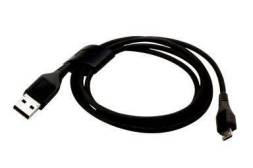
Will you only need USB electronics
Will you only be charging USB devices?
- If you intend to pack USB powered electronics such as mobile phones or tablet computers for Ethiopia then we suggest just packing a travel USB wall charger.
- If you only use a simple power plug adapter you'll still need to use your domestic USB power charger as well. [7] [AD]
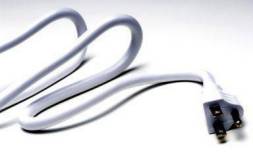
Will you need to power appliances
What types of electrical devices do you want to charge with an Ethiopian power outlet?
- There are 3 types of electrical devices or appliances:
- Low wattage electronic items which can be plugged into a power outlet - for example a laptop.
- High wattage electrical appliances which can be plugged into a power outlet - for example clothes irons and hair dryers.
- USB devices that connect to a USB port - for example mobile phones or tablets.
- Should you only want to bring along just USB powered devices to Ethiopia then a travel USB charger is ideal as you'll only need to bring that single compact charger and some appropriate existing USB charging cables rather than needing to pack a collection of domestic chargers.
- Travel power strips are built for providing power and converting voltage for several low wattage devices, but won't work with high wattage appliances (such as hair straighteners) which need voltage conversion.
Will your devices work with 220 volt power outlets?
- Ethiopia uses 220 volts, if you travel from a country which doesn't use 220 volts and you don't have a dual voltage appliance (how to tell) then you will either need to pack a bulky power converter or a power strip with a built in power converter.
- It can be more expensive to buy a voltage converter rather than using a dedicated dual voltage travel appliance (for example a dual voltage hair dryer, clothes iron, hair straighteners or curling iron for Ethiopia) which is perfect for travel and often includes plug adapters.
Do you plan on visiting countries other than Ethiopia?
- A simple power adapter will only typically operate in a single country, therefore if you are visiting multiple countries then you may need to bring additional power adapters which can add to the weight you have to bring.
- Alternatively, travel USB wall chargers and universal travel adapters are designed for going to multiple countries due to their interchangeable head system.
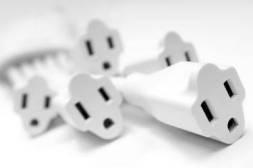
Are multiple outlets available
How many wall outlets will be available when you arrive in Ethiopia?
- Your hotel might have only one wall outlet, this will present a problem when charging batteries of multiple items such as phones, tablet computers and cameras overnight as you will only be able to recharge a single device at a time then have to continually swap after each device has charged.
- If you want to charge multiple devices simultaneously then we suggest packing either a travel USB wall charger or a travel power strip that can power multiple USB ports and outlets. [6] [AD]
Are you intending on visiting anywhere else abroad in the future?
- A USB charger with interchangeable heads or universal travel adapter can be reused for future trips to other countries.
How much can you afford to pay?
- A basic power adapter which charges one device in a single country (providing that it is dual voltage or works with 220 volts), however paying a little more allows you to charge multiple devices simultaneously and use them in multiple different countries.
Would you like to use your charger when returning to America?
- Most types of travel USB wall chargers and travel power strips might also be useful when you get back to America.

Are you bringing just hand baggage
Are you only bringing hand luggage to Ethiopia?
- Due to their increased size power converters and power strips could be way too bulky for carrying in carry-on baggage, we recommend bringing either a USB wall charger or a universal power adapter. [8] [AD]
Will the area of Ethiopia you are staying in have reliable access to electrical power?
- The power in Ethiopia could occasionally fluctuate which could cause damage to your devices, use an adapter which has surge protection built in such as a travel power strip.
- Due to Ethiopia suffering with power cuts or having limited coverage of electricity you might discover that whichever power charger you use won't work anyway. You can prepare for limited electricity and power cuts by using a portable charger or a solar backpack. [4] [4] [16] [AD]

Arriving at an airport
Are you flying long haul to get to Ethiopia?
- If you're taking a long journey to get to Ethiopia it's worth thinking about packing an charger which is perfect for airports that works in different outlet types, one that can be carried in hand luggage and can be used to quickly power tablets and phones.
- Not all flights have power outlets so we recommend using a portable charger for recharging on the go. When you land you could need to rely on a cell phone to make a telephone call, reading emails , using mapping to find a hotel or reading your itinerary; so ensure that your phone will have enough battery power left. [4] [AD]
What can I connect to an Ethiopian power outlet
Travel appliances that can plug into an Ethiopian power outlet
Beats Pill speakers which can connect to an Ethiopian power outlet
Jabra Bluetooth speakers which are compatible with an Ethiopian power outlet
Mobile phones which can connect to the Ethiopian power outlet
Apple iPhones which work with the Ethiopian power outlet
Samsung Galaxy phones that work with an Ethiopian power outlet
Amazon Kindle tablets which work with an Ethiopian power outlet
A list of Apple iPads which are compatible with an Ethiopian power outlet
Corrections
We endeavor to ensure all details on this page are correct and relevant to travellers visiting Ethiopia, if you wish to contribute any useful information or feedback please email travel@wikiconnections.org. For more comprehensive technical details visit the Wikipedia page on AC power plugs and sockets. [19]
Disclaimer
WikiConnections is not responsible for any injury or damage caused due to using any type of suggested product with any other electrical device or appliance in any location, full details are available on the disclaimer page. While WikiConnections strives to make the information on this website as timely and accurate as possible, we make no claims, promises, or guarantees about the accuracy, completeness, or adequacy of the contents of this site, and expressly disclaim liability for errors and omissions in the contents of this site. All functions and capabilities should be checked prior to purchasing or using any power adapter. Assumptions on if any power adapter, charger, converter or power strip works in any location is based on data from publicly available sources and if it fits the primary power outlet used in that country. WikiConnections has not taken into consideration other less common power outlets which might be found as these might only be used in certain areas or in the process of being phased out.
Where possible, WikiConnections only recommends the type of product as being suitable along with alternatives and does not make any endorsement for any specific brand or product. Always check with the manufacturer to ensure full compatibility prior to attempting to use any device. Always check the reputation of the manufacturer and product to ensure the quality and safety of any electrical device being used.
External links
We endeavour to ensure that links on this page are periodically checked and correct for suitability. This website may receive commissions for purchases made through links on this page. As an Amazon Associate WikiConnections earn from qualifying purchases. For more details please read the disclaimers page.
- Wikipedia - Ethiopia country page on wikipedia.org.
- iec.ch - International Electrotechnical Commission World Plugs
- Type E plug adapter - A CEE 7/5 socket and CEE 7/6 plug compliant Type E adapter designed with a focus on safety, featuring two round pins and an earthing hole. Ideal for use in the France, Belgium, Poland and several African nations..
- Portable charger - Portable chargers are invaluable batteries for travel, especially in unfamiliar locations. Advanced charging technologies offer fast and efficient power delivery to mobile phones, tablets and headphones via USB ports..
- Wikipedia - power adaptor
- Travel power strip - Combining surge protection, AC outlets, USB ports and swappable plug adapters, the travel power strip is a comprehensive power solution for global travellers..
- 4 Port USB Wall Charger - A 4-port USB wall charger is an electrical device that provides simultaneous charging for up to four USB-compatible devices. It often includes interchangeable international plug adapters for global use..
- Universal travel power adapter - The universal travel power adapter is a versatile single solution for power on the go, compatible in over 150+ countries worldwide. A single unit compact design makes it a travel essential which easily fits into any travel bag..
- Plug adapter set - A plug adapter set is a future-proof travel essential, containing various adapters to fit diverse power outlets around the world to ensure compatibility in a wide range of countries..
- Step down power converter - Step-down power converters are engineered to safely convert higher voltages of 220V / 240V to 110V / 120V, allowing the use of appliances designed for lower voltage systems to be used in countries with higher voltage power outlets..
- Wikipedia - WikiPedia - Mains electricity by country -
- Rechargeable hair dryer - Rechargeable hair dryers ideal for travel are lightweight and cordless for mobility, have low-heat settings for hair health, and a fast-charging battery for time efficiency. Additional LED indicators can help monitor battery life..
- Rechargeable cordless flat iron - Modern rechargeable cordless flat irons use advanced battery technology for consistent temperature control. Suitable for airline safe travel with universal voltage and USB charging capabilities..
- 20,000mAh portable charger - A high-capacity charging device featuring 20,000mAh energy storage, capable of multiple charge cycles for mobile phones and some tablets. Suitable for extended periods away from power sources..
- USB-C PD power bank - A USB-C PD power bank utilises Power Delivery technology to facilitate high-speed charging, particularly for laptops requiring substantial power. A high wattage power bank ensures fast and efficient energy transfer, supporting USB-C enabled devices..
- Solar backpack - Incorporating large solar panel with USB outputs, solar backpacks are ideal as a reliable secondary source of energy for device charging in remote travel locations where electrical outlets are unavailable or unreliable..
- Solar power bank - Solar power banks integrate photovoltaic cells to offer a self-sustaining charging option, ideal when a backup power source is required for locations where electrical outlets are unreliable, scarce or unknown..
- Heavy duty power converter - Heavy-duty power converters robust voltage transformation capabilities for designed for high-wattage devices, making them best suited for appliances like kettles and hair dryers that consume a significant amounts of power..
- Wikipedia - AC power plugs and sockets -